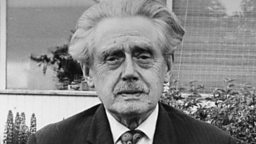Edwin Morgan
1920 - 2010
Biography
Edwin George Morgan was born on 27 April 1920 in the West End of Glasgow. He went to Glasgow University to study English literature in 1937. While at University Morgan also studied French and Russian. The Second World War then interrupted his studies. From 1940 Morgan served in the Royal Army Medical Corps. Returning to Glasgow in 1946, he graduated with first class honours the following year. Morgan then joined the staff of the English Literature Department after turning down a scholarship to Oxford. He worked as a lecturer at Glasgow until his retirement as a professor in 1980.
Morgan’s first book of poetry was published in 1952. Since then he has continued to live and work in Glasgow, producing work which has received increasing recognition at both home and abroad. In the 1960s Morgan became involved in the international concrete poetry movement, corresponded with concrete poets in Sao Paulo, Brazil, and became, along with Ian Hamilton Finlay, perhaps the major exponent of concrete poetry in these Islands. A committed internationalist, Morgan has been a prolific translator, producing versions of poems and plays from a large number of languages.
Edwin Morgan’s work has received a number of prestigious accolades and has assumed an increasingly public role. In 1999 he became Glasgow’s first official Poet Laureate and a year later received the Queen’s Gold Medal for Poetry. Most recently, in 2004, Morgan became Scotland’s first official national poet or ‘Scots Makar’, charged with ‘representing and promoting Scots poetry’. In the years after his appointment to the Glasgow laureateship Morgan was an active supporter of the repeal of Section 28, criticising Church and business leaders for their support of the ‘Keep the Clause’ campaign. This endorsement of gay rights and inclusive attitudes to social and cultural difference characterised his publicly liberal stance in the 1990s and into the 21st Century.
Edwin Morgan died in Glasgow on 19 August, 2010.
Works
Edwin Morgan’s output as a poet, critic and translator has, since the publication of his first book, The Vision of Cathkin Braes (1952), defied definition in its variety. Morgan has published sonnets, concrete poems and sound poems, science fiction poems and vivid portraits of his native Glasgow, essays on many subjects and translations from a wide number of different languages, genres and historical periods.
In the early 1960s Morgan began publishing in short pamphlets the experimental poetry which would lead to The Second Life (1968), often thought to be his first major collection. The Second Life brought together some of this experimental poetry along with some of the love poems and Glasgow poems for which Morgan would become best known in Scotland. Morgan’s experimental work takes many forms. The concrete poetry relies for part of its effect on the visual impact of the way words and spaces are arranged on the page. ‘The Chaffinch Map of Scotland’, for instance, uses the different Scots words for ‘chaffinch’ and arranges them to create a map in which the eye is directed towards the one instance of the word ‘brichtie’, somewhere in the south west of the country. Other poems, printed earlier as the Emergent Poems in 1967, take a phrase from world literature and reproduce it several times with different letters missing so that a new poem emerges. The Second Life also included poems which talk, often in coded terms, about gay love, and portraits of gay life in Glasgow, including the now famous ‘Glasgow Green’.
Morgan’s next major collection was From Glasgow to Saturn (1973), a reference to Morgan’s interest in space exploration. Here Morgan included both experimental work and poems in traditional verse forms. The sound poem ‘The Loch Ness Monster’s Song’ sits alongside the ‘Glasgow Sonnets’. A feature of Morgan’s poetry which is exemplified throughout this collection is his habit of speaking through voices, whether of historical characters, as in ‘Columba’s Song’, or of objects we don’t normally think of as having a voice, as in ‘The Apple’s Song’ or ‘The Computer’s First Code Poem’.
The Sonnets from Scotland were published at a time when writers were experimenting with new ways of representing Scotland, and Glasgow in particular, sometimes making use of mythic or fantastic elements to give depth and freshness to their representations. When first published in 1984, Morgan’s Sonnets were illustrated by Alasdair Gray, whose novel Lanark (1981) had offered new ways forward through the juxtaposition of fantasy and realism. Morgan himself has suggested a link between this new outpouring of poetry and fiction in the years following the failed devolution referendum of 1979.
The sequence begins with the words ‘There is no beginning’ (‘Slate’ in Collected Poems, 437) and goes on to describe Scotland as it existed before there were people to see it, at the point of its geological formation: ‘We saw Lewis / laid down, when there was not much but thunder / and volcanic fires; watched long seas plunder / faults; laughed as Staffa cooled’. The sequence goes on to bring together characters and voices from across Scottish history and prehistory to the future Respublica Scotorum of the later sonnets. Sonnets from Scotland creates an assembly of voices where St Columba and St Mungo rub shoulders with Glasgow folksinger Matt McGinn. The ‘we’ of these poems offer an extra-historical, perhaps even extra-terrestrial perspective on Scotland and its people. Morgan’s Sonnets are an imaginative attempt to move beyond the limitations of the here and now.
In 1997 Morgan published Virtual and Other Realities. This collection brings together two commissioned works, reflecting Morgan’s position as an established figure in Scottish cultural life. ‘The Five Pointed Star’ was written for the Burns Bicentenary in 1996, while ‘Beasts of Scotland’ was commissioned by the Glasgow International Jazz Festival and then set to music by the saxophonist Tommy Smith. These works, along with ‘The Voyage’, a poem about the process of conception, open a collection centred on the title sequence. Virtual and Other Realities, a series of poems in rhyming three-line verses, demonstrates the curiosity central to Morgan’s poetry, embracing modern technologies and the effects these might have upon human perception.
Cathures (2002), which takes its name from the oldest known name for Glasgow, saw Morgan’s imagination return to his native city. The collection includes Morgan’s Glasgow Laureate poems. As with elsewhere in Morgan’s poetry, many of the poems in Cathures are monologues in which Morgan displays his interest in ‘presenting characters … to make them as distinctive and real as I can in short space, to give them all the life I can’ (Interview in Colin Nicholson, Poem, Purpose and Place: Shaping Identity in Contemporary Scottish Verse). Cathures also includes Demon, a sequence of poems first published in 1999.
Reading Lists
Primary – Poems and Translations
Starryveldt (1965)
Emergent Poems (1967)
Gnomes (1968)
The Second Life (1968)
The Horseman's Word: A Sequence of Concrete Poems (1970)
Twelve Songs (1970)
Instamatic Poems (1972)
Rites of Passage (1976)
The New Divan (1977)
Poems of Thirty Years��(1982)
Grafts/Takes (1983)
Sonnets from Scotland (1984)
Selected Poems (1985)
Newspoems (1987)
Tales from Limerick Zoo (1988)
Themes on a Variation (1988)
Collected Poems (1990)
Crossing the Border (1990)
Nothing Not Giving Messages (1990)
Hold Hands Among the Atoms (1991)
Edmond Rostand's Cyrano de Bergerac (1992)
Cecilia Vicuña, PALABRARmas / WURDWAPPINschaw (1994)
Sweeping Out the Dark (1994)
Collected Translations (1996)
St. Columba. The Maker on High (Translation) (1997)
Virtual and Other Realities (1997)
"Planet Wave", in: PN Review 119, Vol. 24, No. 1 (Jan. - Feb. 1998).
Christopher Marlowe's Doctor Faustus. In a New Version by Edwin Morgan (1999)
Demon (1999)
Jean Racine. Phaedra (Translation) (2000)
New Selected Poems (2000)
A.D. A Trilogy of Plays on the Life of Jesus Christ (2000)
Attila József. Sixty Poems translated by Edwin Morgan��(2001)
Beowulf. A Verse Translation into Modern English (1952)
Cathures��(2002)
Love and a Life. 50 Poems by Edwin Morgan (2003)
Articles and essays
Essays (1974)��
"Into the Constellation: Some Thoughts on the Origin and Nature of Concrete Poetry", in: Morgan, Edwin, Essays (1974)
Hugh MacDiarmid, ed. by Ian Scott-Kilvert, published for The British Arts Council (1976)
"Scotland and the World", in: Chapman 95 (2000), pp. 2 - 15
Secondary
Edwin Morgan: a selected bibliography, 1950-1980, ed. by Hamish Whyte (1980)
Robin Hamilton, Science & psychodrama: the poetry of Edwin Morgan and David Black (1982)
Geddes Thomson, The poetry of Edwin Morgan (1986)
About Edwin Morgan, ed. by Robert Crawford and Hamish Whyte (1990)
Felt-tipped hosannas: for Edwin Morgan on his 70th Birthday (1990)
Unknown is best: a celebration of Edwin Morgan at eighty, ed. by Robyn Marsack and Hamish Whyte (2000)
Nicholson, Colin, Edwin Morgan : inventions of modernity (2002)
Related Links

Writing Scotland themes
-
![]()
by Carl MacDougall





